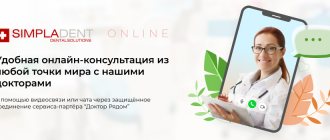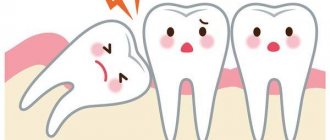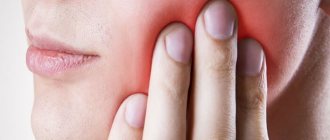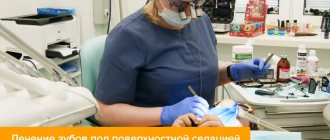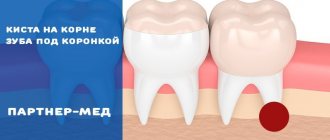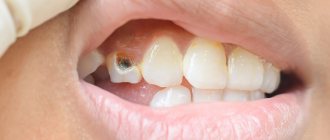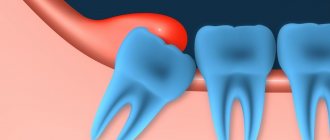Anesthesia and its types
There are quite a few different types of anesthesia, but only three are mainly used in dentistry:
- local anesthesia;
- sedation or drug-induced sleep;
- general anesthesia or general anesthesia.
The choice of anesthesia depends on the complexity and duration of the treatment, as well as the characteristics of your health. During treatment, you will be under constant supervision of leading anesthesiologists from Yekaterinburg, who will continuously monitor the process and closely monitor your vital signs during the procedure.
Treatment of children under general anesthesia
For many parents, the decision to perform dental surgery on a child under general anesthesia is still very difficult. This is due to general anxiety, various horror stories from the Internet and the lack of qualified answers to all questions about anesthesia in dentistry. But dear parents, first you need to clearly understand that no matter how small your child is, no matter how capricious he is, no matter how afraid he is, he has the right to high-quality dental treatment, and this is not a whim of the dentist, but a chance for complete long-term stabilization caries process in the oral cavity. And if you persuaded the doctor to hold the child by force and somehow put a filling on a screaming child, then we are not talking about providing quality care at all.
Today, the indications for treating a child under medicated sleep conditions are:
- child's age up to three years
- large volume of intervention (multiple complicated caries)
- the presence of systemic diseases (neurological, psychiatric in nature, including)
- increased emotional excitability of the child
- intolerance to local anesthetics or cases of allergic reactions to them
- the presence of teeth that already hurt, not giving the child a chance to gradually adapt to dental procedures
Today, the drug Sevoran is used in pediatric dentistry. This is a liquid that is converted into gas for inhalation using special equipment. There are no absolute contraindications to this drug; it is used even in cases of severe illness and disability in a child. All treatment takes place under the constant supervision of the anesthesiological team; every vital parameter of the child’s body is monitored in real time. We are rightfully proud of our anesthesiologists; their experience, qualifications, responsibility and super attentive attitude towards each child are the key to the success of all our rehabilitations.
And our equipment is one of the best in the city!
A very important question concerns parents: how to properly prepare for such complex treatment?
For each child there are a number of tests and examinations that are necessary for the anesthesiologist. They allow you to understand whether there is any infectious disease at the moment, whether there are any anomalies in the development of the cardiovascular system, and what is the general condition of the child’s body at the time of oral cavity sanitation. These examinations have their own statute of limitations, and at the preliminary consultation, the dentist tells you what will be necessary specifically for your child in order for everything to go smoothly.
Temporary contraindications for treating a child under general anesthesia will be:
- elevated temperature
- vomit
- diarrhea
- cough and snot
The most important point in preparing for this type of treatment is to maintain a four-hour interval of time during which you cannot feed and water the child. Therefore, depending on the usual daily routine, we try to choose the optimal time for treatment - this is either early morning, or vice versa, time closer to lunch. This is an extremely important requirement, guaranteeing the absence of nausea and vomiting in the postoperative period, and therefore the child’s well-being.
Before any intervention begins, the child must be examined by an anesthesiologist, talk with the parents, and ask questions about the child’s condition at a given time. It is the anesthesiologist who makes the decision about the possibility of performing this type of anesthesia for a particular child.
And only after complete immersion in medicated sleep does the dental part of the treatment begin. Thus, the child does not see or hear all the moments that frighten him, which means he does not develop a fear of the dentist, as well as a fear of any dental procedures.
When treating under general anesthesia, we manage to achieve the highest quality results in one visit. The purpose of sanitation is to eliminate all types of infection in the oral cavity, so every tooth is treated, but if any of the teeth, unfortunately, cannot be saved, then the tooth must be removed. Removal will also be carried out during medicated sleep.
During treatment under general anesthesia, the doctor has the opportunity to apply all the most necessary manipulations and procedures that would be impossible during treatment while the child is awake; it is also a very important fact that the treatment of a larger number of teeth takes place much faster under anesthesia, since it is not required separate isolation for each tooth, separate local anesthesia, and so on. We also take dental diagnostic photographs while under anesthesia if the child was not ready to take them at the preliminary consultation. We understand how worried parents are, and we don’t waste a single extra minute in anesthesia! We have a very qualified team, thanks to which we can carry out a fairly large amount of treatment in just two to three hours!
When everything is over, the child wakes up in the room where his parents are already waiting for him. The child is under the supervision of an anesthesiologist for about an hour.
What is important to know for the period after treatment is that teeth may bother you during the first 24 hours, this is normal, especially if a large amount of treatment has been carried out, there have been extractions, and so on.
You may also experience a sore throat, dizziness, and drowsiness. All these phenomena quickly pass if parents follow the recommendations of the anesthesiologist.
And then begins the painstaking work of eliminating all risk factors for caries in the child, careful oral care, following all the dentist’s recommendations, regular preventive examinations and the child’s gradual adaptation to independent treatment!
Anesthesia and sedation: what is the difference?
Patients often confuse anesthesia with sedation, which is used in most cases, but the difference between them is quite significant.
During dental treatment under sedation, the patient is immersed in a light form of sleep, which eliminates emotional discomfort, fear of unpleasant procedures, and also ensures complete peace of mind. Using sedation, the patient partially retains consciousness, reaction to verbal stimuli, the ability to contact others and all physiological reflexes.
Anesthesia also artificially puts the patient into sleep, but into a deeper state. In the process, the activity of the central nervous system decreases, pain sensitivity is lost and reflexes are partially eliminated.
several methods for comfortable induction of a patient into anesthesia
- intravenous anesthesia;
- inhalation, which is carried out using nitrous oxide supplied through a breathing mask along with oxygen;
- combined anesthesia entering the body simultaneously through the blood and respiratory tract.
The choice of anesthesia and method of administration is determined by the doctor individually for each patient and depends on the duration of treatment, its complexity and health characteristics.
Simple tooth extraction
The most common dental surgery is simple extraction. It may be typical or atypical. In any case, the dentist must ensure the patient’s comfort and painlessness of the procedure, control all stages and eliminate the risk of complications. Manipulations are performed in strict sequence:
- anesthesia,
- syndesmotomy – destruction of the dental-gingival junction,
- application, advancement and fixation of forceps,
- loosening of the tooth and its removal,
- detailed inspection of the hole,
- if necessary, suturing it.
The dentist uses certain types of forceps to remove molars from the lower and upper jaws. Grasping of incisors, anterior teeth, molars and premolars is also done differently. The position of the doctor relative to the patient is different, and the patient must understand that everything the doctor does, he does for the benefit of the patient, and try not to interfere with him.
Indications and contraindications
At the European Dental Center, dental treatment during sleep can be performed for both children and adults. The main indications for this procedure are:
- insurmountable fear of dental treatment;
- allergy to local anesthesia or its ineffectiveness;
- pronounced gag reflex;
- dental treatment for children who find it difficult to remain in one position for a long time;
- long hours of dental procedures;
- complex tooth extraction or jaw surgery.
It is not recommended to treat or remove teeth under anesthesia in patients with:
- breathing problems;
- diabetes mellitus in the stage of decompensation;
- acute heart failure;
- myocardial infarction suffered during the last 6 months;
- pregnancy.
The indications for dental treatment under anesthesia are determined by the doctor, and the anesthesiologist individually calculates the dosage of the drug and selects the appropriate type of anesthesia or anesthesia.
Feedback from a patient after treatment under anesthesia
Wonderful clinic. Nice atmosphere. The treatment was under anesthesia.
Anastasia Viktorovna is a qualified doctor, she explains and tells everything. Children run to see her. Anton Pavlovich is a good specialist, he explained and told everything. Thank you very much!
The staff is polite, attentive and responsive. Thank you all very much. We will continue to come here
Bykova Elena Alexandrovna. See other reviews about the center...
Complex tooth extraction
Complex removal, for example, of wisdom teeth, requires the use of a larger set of tools and takes longer. The technique is used when working with
- impacted wisdom teeth,
- incorrectly located molars,
- molars with two and three roots,
It is considered difficult to remove a tooth with a cyst on the root, in the presence of fistulous tracts, if the bone tissue of the jaw and the molar root are fused.
But this dental operation is not fatal and not scary if it is performed by a qualified and responsible doctor. If difficult removal is indicated, then after anesthesia the following manipulations will be performed:
- incision of the gum and removal of its tissue from the neck of the tooth,
- removal of part between the root septum, if necessary,
- applying and fixing the forceps as deeply and tightly as possible,
- rocking and extracting the tooth body,
- placing one or more sutures on the operated area of the gum.
For complex removal of wisdom teeth or “eights”, not only dental forceps are used, but also an “elevator” and a drill. The period of gum restoration and its duration depend, first of all, on the patient himself and the accuracy of his compliance with the doctor’s recommendations. If there are no complications, tissue regeneration occurs within a week.
Preparation for the process
1) First, you should sign up for a free consultation with a dentist. The doctor will conduct a detailed examination, draw up a treatment plan and tell you in detail about the upcoming procedures, and then refer you to an appointment with an anesthesiologist;
2) the anesthesiologist will consult you, draw up a list of necessary tests for a comprehensive examination and select the most suitable type of anesthesia. Laboratory tests must be taken no later than 5 days before the patient is put into deep medicated sleep;
3) based on the results of the examination and the conclusions of the anesthesiologist, the day of the procedure is set, and the patient receives individual recommendations.
Our pediatric dentistry offers the following services:
- treatment of diseases of primary teeth;
- correction of the bite, even in the most difficult cases;
- carrying out diagnostics;
- conducting detailed consultation on treatment methods, equipment, hygiene.
The Estetic Art dental clinic will take care of the health of children and a careful approach to young patients.
Our children's dental clinic uses only the most modern and high-quality equipment in combination with proven materials. At the same time, the price level can pleasantly please parents who are concerned about the health of their children.
Why us?
- Painless
Dental treatment under anesthesia guarantees the absence of discomfort and anxiety, and several manipulations can be performed at once in one visit.
- Professionally
Dental treatment using anesthesia is carried out under the supervision of leading anesthesiologists from Yekaterinburg and the head of the anesthesiology department. All specialists at our center have extensive practical experience in the field of surgical, therapeutic and aesthetic dentistry.
- Safely
We use only the best and proven materials and equipment, the effectiveness and safety of which are confirmed by clinical trials.
Causes of dental phobia
The most common reason for fear of dental treatment is the patient’s personal negative experience when visiting the dentist in early childhood, especially in cases where teeth had to be treated without local anesthesia. According to recent studies, dental phobia can also be inherited: the past behavioral experience and psycho-emotional state of parents when visiting the dentist are consciously or unconsciously captured and adopted by children.
Modern dentistry allows you to treat teeth without fear and pain.
Why patients are afraid to go to the dentist:
- The influence of the media space - negative coverage of dental techniques in the media, demonstration of the painfulness of procedures in cinema, animated films, etc.;
- The presence of negative treatment experience in other areas of medicine;
- A feeling of helplessness and loss of control in the dentist's chair, which in turn causes fear.
But, whatever the reason for fear of the dentist, modern medicine offers a lot of effective solutions that allow teeth to be treated even for those patients who suffer from particularly acute dental phobia. One example of solving this problem is the use of sedation during dental procedures.
Prices for treatment under anesthesia
| Initial consultation | For free! | ||
| Sedation for adults (1 hour) | 10000 | ||
| Anesthesia for adults (1 hour) | 12500 | ||
| Children's anesthesia (1 hour) | 12500 | ||
| Treatment under anesthesia | |||
| Therapy | +20% to cost | ||
| Periodontology | +20% to cost | ||
| Surgery | +100% to cost | ||
| Implantation | +10% to cost | ||
| Orthopedics | +10% to cost | ||
| Pediatric dentistry under anesthesia | |||
| Professional oral hygiene | from 3500 | ||
| Treatment of caries of baby teeth | from 4500 | ||
| Treatment of pulpitis of a baby tooth | from 9000 | ||
| Removal of a tooth | from 2500 | ||
| Fissure sealing | from 2200 | ||
The indicated price list is for informational purposes only, does not constitute an offer and does not contain a complete list of services provided. Prices correspond to the specific manipulation. The full cost of a particular service will be announced by a specialist after an examination and consultation.
To make an appointment please call
Possible complications during general anesthesia
There are many side effects of general anesthesia. Sometimes, even in the absence of contraindications, the body's reaction to an anesthetic can be unpredictable, so anesthesia is always a risk. The following complications may occur:
- Decreased cognitive function of the brain;
- Difficult recovery from anesthesia, prolonged confusion;
- Dizziness;
- Nausea and urge to vomit;
- Strong headache;
- Muscle pain;
- Injury to the oral cavity (tongue, teeth, lips);
- Respiratory tract infection;
- Severe brain damage, death (the percentage of cases is minimal).
